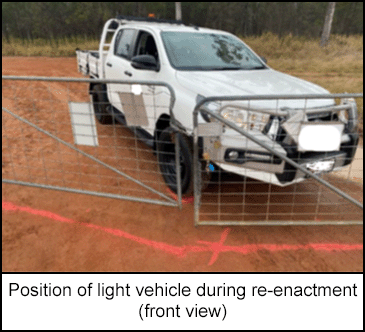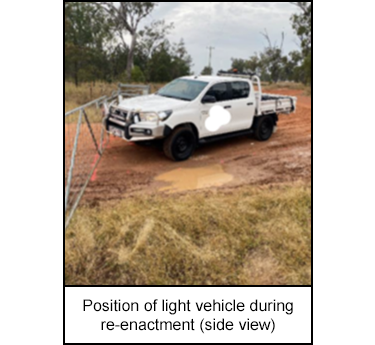-
What happened?
A worker was driving a light vehicle to conduct scheduled inspections and maintenance when they decided to inspect an additional well that wasn’t planned for this particular day.
The worker stopped the vehicle at the property entrance gate and got out of the vehicle to unlock the gate.
The vehicle rolled forward, pinning the worker against the gate. The worker was unable to free themselves.
A passing Contractor noticed the situation, offered assistance and reversed the vehicle away from the gate.
The worker was transported to a paramedic for a check-up and treated for minor bruising.

-
Why did it happen?
The worker exited the vehicle to open the property access gate without placing the vehicle’s transmission into ‘park’ and without effectively applying the handbrake.

-
What did they learn?
Investigate the viability of fitting light vehicles with an audible door alarm when the vehicle transmission isn’t in “park” (for automatics) and when the handbrake isn’t engaged (manuals and automatics).
When travelling alone, drivers should wear a lone worker device, or carry a radio, when exiting the vehicle – even when just leaving the vehicle to open a gate.

-
Ask yourself or your crew
Do you travel alone in a vehicle when you’re working in the field?
How many gates would you open and close during a typical work-day?
What controls do you have in place to manage vehicle immobilisation risks?
Do you rely solely on drivers remembering to apply their vehicle’s handbrake?
When conducting highly repetitive routine tasks, how do you prevent yourself becoming complacent?
When did you and your work mates last have a conversation about the potential dangers of hurrying to “get the job done”?

Add to homescreen
Content name
Select existing category:
Content name
New collection
Edit collection
What happened?
A worker was driving a light vehicle to conduct scheduled inspections and maintenance when they decided to inspect an additional well that wasn’t planned for this particular day.
The worker stopped the vehicle at the property entrance gate and got out of the vehicle to unlock the gate.
The vehicle rolled forward, pinning the worker against the gate. The worker was unable to free themselves.
A passing Contractor noticed the situation, offered assistance and reversed the vehicle away from the gate.
The worker was transported to a paramedic for a check-up and treated for minor bruising.

Why did it happen?
The worker exited the vehicle to open the property access gate without placing the vehicle’s transmission into ‘park’ and without effectively applying the handbrake.

What did they learn?
Investigate the viability of fitting light vehicles with an audible door alarm when the vehicle transmission isn’t in “park” (for automatics) and when the handbrake isn’t engaged (manuals and automatics).
When travelling alone, drivers should wear a lone worker device, or carry a radio, when exiting the vehicle – even when just leaving the vehicle to open a gate.
Ask yourself or your crew
Do you travel alone in a vehicle when you’re working in the field?
How many gates would you open and close during a typical work-day?
What controls do you have in place to manage vehicle immobilisation risks?
Do you rely solely on drivers remembering to apply their vehicle’s handbrake?
When conducting highly repetitive routine tasks, how do you prevent yourself becoming complacent?
When did you and your work mates last have a conversation about the potential dangers of hurrying to “get the job done”?
A worker was pinned against a gate by their vehicle after failing to put it in ‘park’ and apply the handbrake while exiting to unlock the gate. A passing contractor assisted, and the worker sustained minor bruising.
Original material courtesy of Safer Together (Australia)
To access the PDF and PowerPoint versions, please visit https://www.safertogether.com.au/resources/sharing-library/driving-person-in-line-of-fire-leb-toolbox













